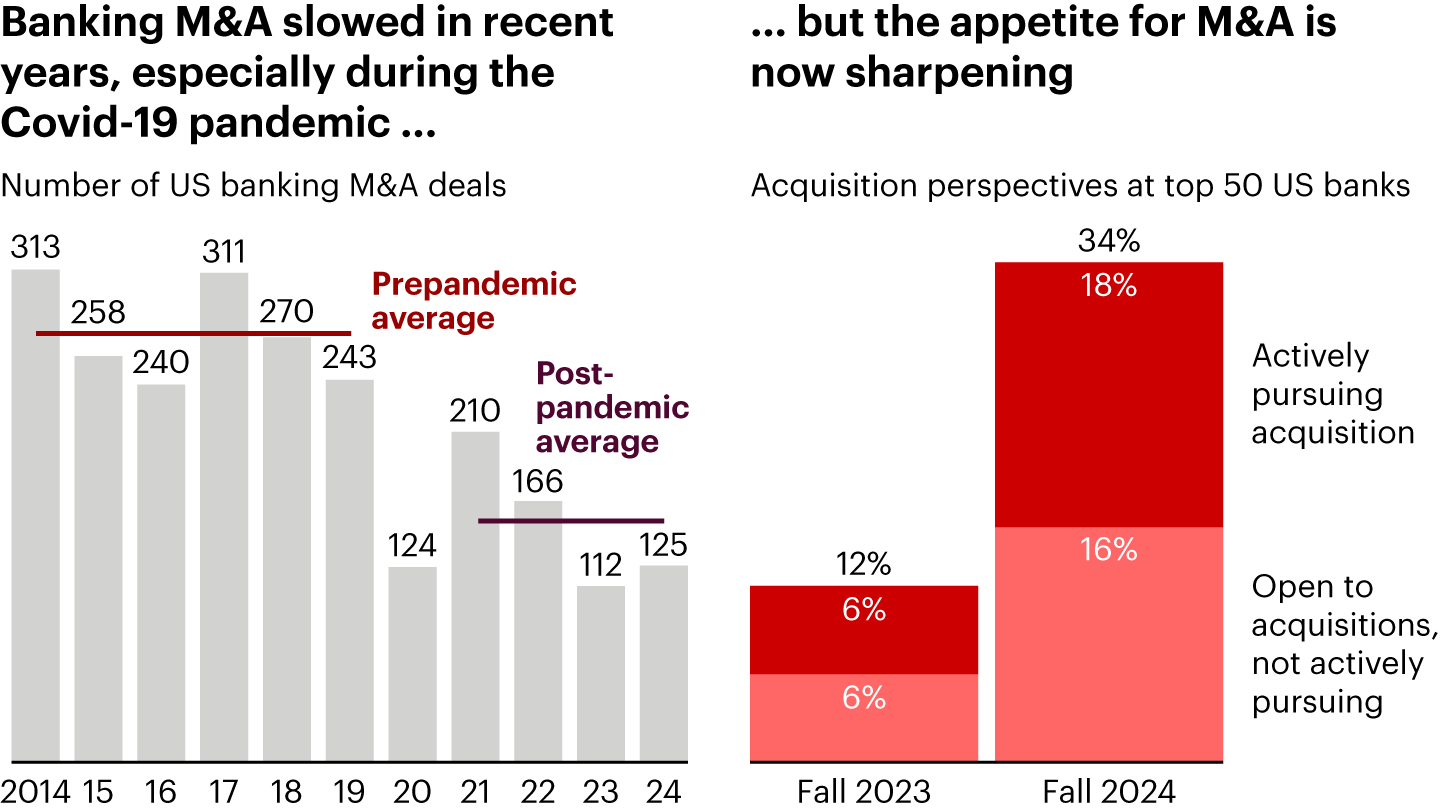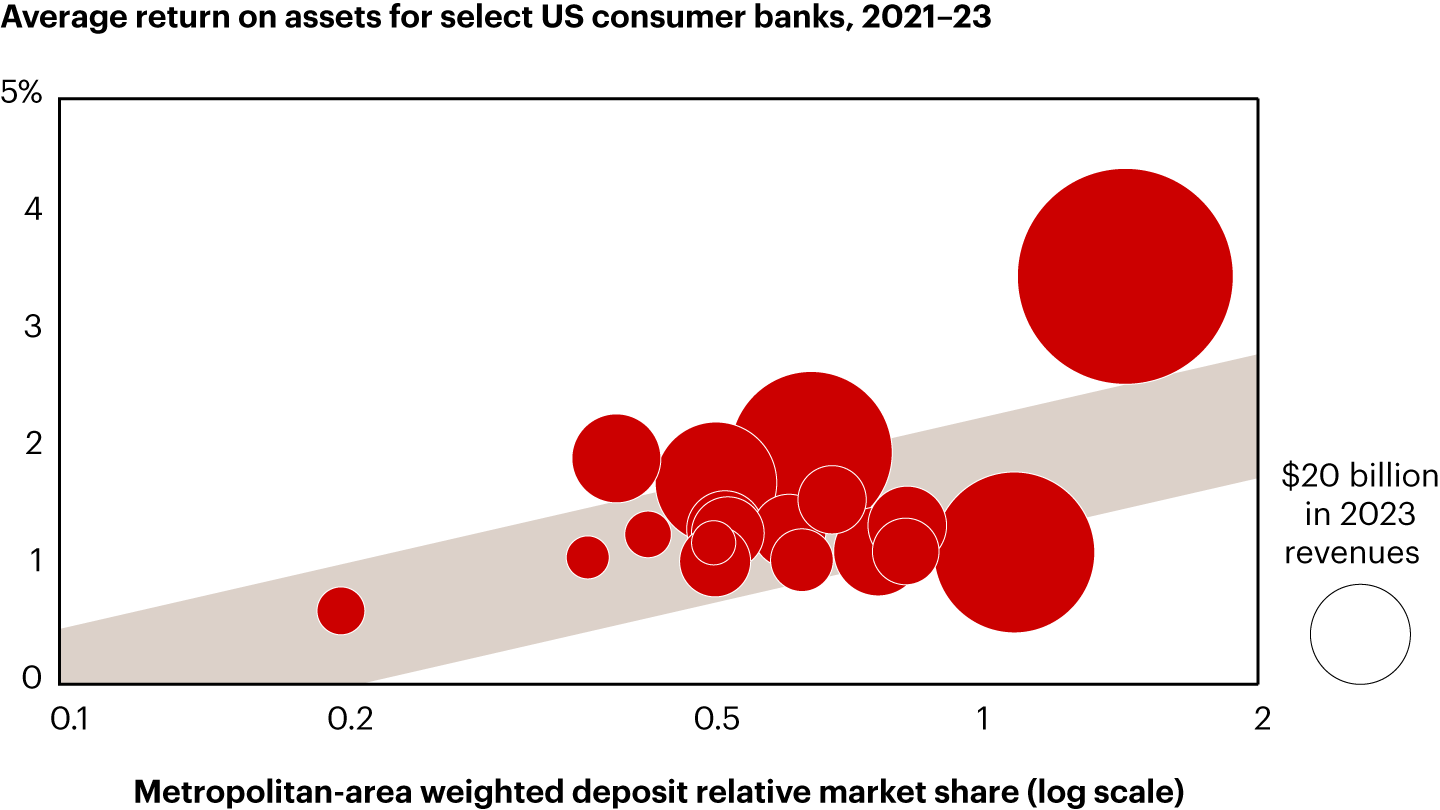Brief

Executive Summary
- After years of hesitation, US banks are eager to pursue mergers due to perceived regulatory easing, declining unrealized losses, and market consolidation.
- Past deal analysis shows that successful bank mergers prioritize local market leadership over national expansion.
- M&A winners anticipate the cost and complexity of IT integration, as IT and business unit collaboration are crucial for smooth transitions.
- M&A success also hinges on preserving customer trust and preventing service disruptions, in order to avoid defections and reputational damage.
After years of regulatory uncertainty and macroeconomic challenges, US banks have renewed their interest in mergers and acquisitions. In 2023, only 12% of the top 50 US banks were open to or actively pursuing acquisitions; by fall of 2024, that number had surged to 34% (see Figure 1).


Notes: Deals data as of December 3, 2024; acquisition perspectives includes publicly traded banks with readily available transcripts; assesses future interest in M&A and excludes integration of already closed deals
Sources: Dealogic; Federal Reserve; S&P Capital IQ; earnings call or presentation transcripts from October 2024, compared to the same period in the prior yearSeveral factors account for this resurgence in M&A:
- Regulatory easing. A change in leadership at regulatory agencies will likely create a more favorable environment for approvals. With fewer antitrust challenges expected and expedited compliance reviews on the horizon, it’s more feasible to make deals.
- Declining unrealized losses. Rising interest rates over the past few years caused large unrealized losses on banks’ investment securities, making them less suitable as acquisition targets. As interest rates stabilize and securities mature, financial flexibility should return for many banks.
- Market consolidation. US banking remains highly fragmented, with smaller banks struggling to achieve economies of scale. Larger regional banks have a solid position to consolidate market share.
Three principles for delivering value
M&A can potentially provide greater value, as financial services firms that leverage M&A frequently and consistently deliver superior returns—7% in total shareholder return per year, on average, vs. about 3% for their less-active peers. Yet it would be dangerous for banks to rush into deals without a disciplined strategy, which might put them at risk of repeating past mistakes. While M&A offers significant upside, historical data shows that many banking deals fail to deliver their intended value. Banking executives should anticipate and avoid the recurring pitfalls by following three principles.
1. Emphasize local market leadership over national scale. Many banks chase a larger national footprint without securing the deposit and lending scale necessary to succeed in each region. Local leadership in deposits and lending matters more than national expansion for earning superior returns (see Figure 2).


As an example, one bank acquired a target with the goal of expanding into new states but failed to reach sufficient scale in key cities. This resulted in a lower relative market share and return on assets after the merger, leaving the combined entity with three times the number of subscale metropolitan areas to deal with.
By contrast, a different bank relied on its local market leadership to expand within the same region over a period of 14 years. Its “string of pearls” approach has trimmed the number of cities where it did not have sufficient scale, and the bank has consistently outperformed competitors in return on assets.
To assess whether a deal will improve market position, a bank can use relative market share benchmarks. And for the regions where it cannot establish local leadership, the bank should consider divesting noncore assets.
2. Recognize the cost and complexity of technology integration. Merging core banking systems, digital platforms, and data infrastructure is one of the riskiest aspects of any bank merger. Many banks underestimate how complex the endeavor will be, leading to big cost overruns and service disruptions. Problems often involve incompatibility of legacy systems, requiring expensive custom solutions; misalignment between IT and business teams, causing operational bottlenecks; and poor planning for system migration, leading to unexpected service outages.
Instead of treating IT integration as a post-merger activity, M&A leaders use analytics—now supported by artificial intelligence—to assess compatibility risks in both organizations before the deal closes. The work is done by a team consisting of IT and business staff, managed by leaders from both groups. And once the systems combine, M&A leaders monitor operational performance and customer feedback in real time.
3. Keep tabs on customers’ experience. Customer attrition—clients leaving the bank or migrating from the primary relationship—is a major, yet often overlooked, risk in M&A. Service disruptions, branding confusion, and weak communication can quickly erode trust and push customers to defect to competitors. One recent merger saw the combined bank’s Net Promoter ScoreSM (a key metric of loyalty) drop by 55% in a single quarter, as customers experienced delays in accessing accounts, issues with online banking, and poor support response times.
Preventing defections requires, above all, service continuity that’s actively monitored and corrected whenever problems for customers pop up. Beyond continuity, it’s important to clearly communicate changes to customers. Incentives such as fee waivers or loyalty benefits may also work well for high-value customers.
Preparing now for the coming merger wave
Although the M&A cycle is turning for US banks, not all will benefit equally. Those that develop a sound integration thesis and take a disciplined approach to local market leadership, seamless technology integration, and customer retention will capture the full value of their acquisitions.
That’s why it pays to start preparing now. A repeatable M&A capability hinges first on a data-driven, strategic rationale tied to long-term growth goals. Bain research has found that 57% of successful deals were preceded by a clearly articulated growth strategy, vs. only 25% of failed deals. Acquisition targets should be based on market position and financial health, evaluated using relative market share benchmarks and risk-adjusted returns. And each acquisition should align with the broader strategy, whether through geographic expansion, enhanced capabilities, or cost synergies.
Along with a solid strategy, execution can make or break a deal. Winning banks answer a set of high-gain questions early on: Has the combined leadership aligned and defined a clear governance structure for integration? Have we set key milestones and success metrics to foster accountability across streams of work? Have we developed a playbook to retain talent?
Regardless of how long or high the coming M&A wave may be, these principles for deal strategy and execution will give banks a foundation to improve their competitive position with customers, regulators, and investors.